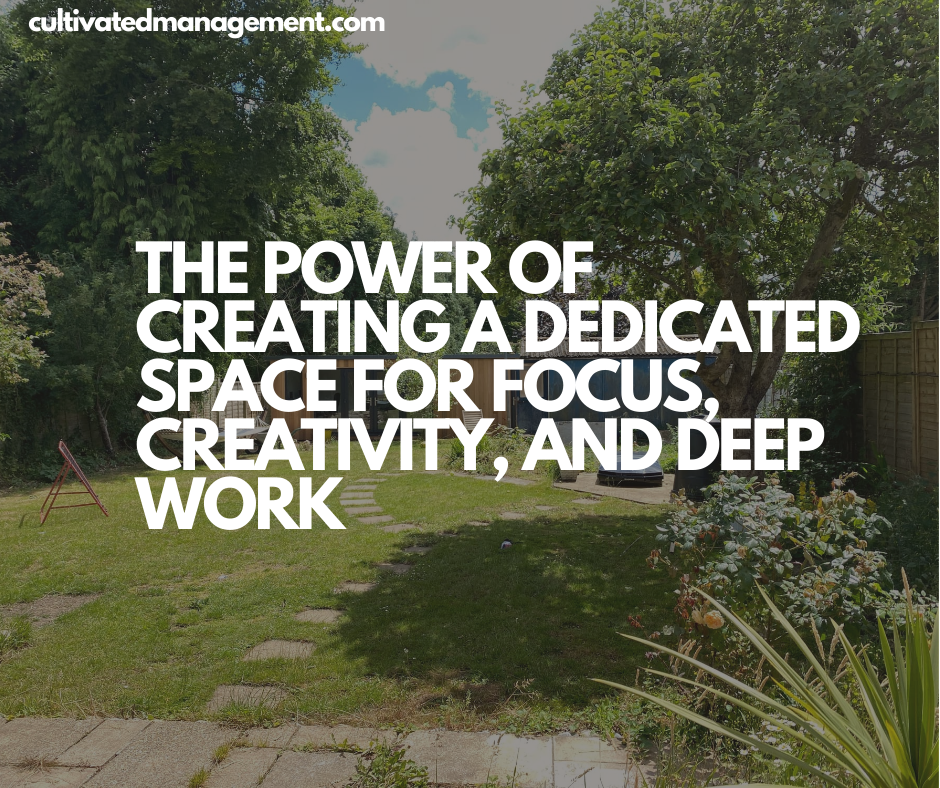
Here’s where we do creative work.
Here’s where we assess product quality.
Here’s where I do workouts.
Here’s where I do deep work.
Here’s where we do “this” work.
In this article, I explore why assigning a physical or virtual space to specific work can dramatically improve focus, creativity, and productivity. And how I do it.
Why a Space Matters
Assigning a space for certain work is a powerful technique known as environmental affordance. It removes obstacles and restrictions, creating both a psychological and physical connection to the task at hand.
I use this idea both personally and professionally. Every team I manage has a dedicated place for important work. I also have spaces for my own activities: consulting, writing, music, art, and relaxation.
Even in a remote world, you can carve out a virtual space for “this” work.
Examples in Action
A few years back, as Vice President, we created a room dedicated solely to creative problem solving.
- No meetings.
- No calls.
- No HR sessions.
- Just creative problem solving.
Over time, the team added:
- Whiteboards and sticky notes
- Inspiring quotes and mood lighting
- Prototyping materials
It became the go-to space for generating ideas, collaborating, and thinking differently.
In another company, we created a learning space: comfy furniture, bookshelves, paper, and mood lighting. Again, only for learning.
My Personal Studio
I'm blessed and lucky to have my own office/studio. This is my overall dedicated space but even within this I have zones for specific activities. By zoning in this way, I can maximise each space - and the purpose it serves.
Consulting and coaching – I have a dedicated standing desk used for work. Consulting, coaching, networking, virtual presentations. As the ceiling is quite low, and I am quite tall – I do look like a giant sometimes. Of course, I can put the desk down and sit.

Digital work – The desk on the right hand side is for creative work. Writing, podcasting (although I often use the standing desk for this 😄) - this is where I write, create books, edit films, edit podcasts and create.
Music and reading – a comfy chair for relaxation

Analogue work and art – I have a writing bureau just for my analogue work and stationery. After all, I do co-host the Stationery Freaks podcast.

No tech, just paper, typewriter, and art supplies
YouTube recording – under construction!

You don’t need a large studio or garden office – I'm extremely grateful for this space. Even a small, dedicated area works fine too.
How It Works
When you assign a space to a specific task, you prime yourself to do that work:
- Remove distractions
- Remove anything unrelated to the activity
- Design the space to support focus, creativity, or relaxation
It’s the same idea as time-blocking. You’re creating a physical boundary for your activity and priming your brain to do a certain activity whilst there.
Even simple habits, like laying out gym shoes the night before work on the same principle: reduce friction and make the desired action easier.
Consider the Environment
Think about:
- Natural light
- Comfort
- Noise levels
- Visual and tactile distractions
Sleep specialists recommend removing TVs and phones from bedrooms. The principle is identical: create a space that supports the activity you want to do.
Make sure you have your supplies, are comfortable, have appropriate lighting and it feels conducive to getting the task/work/activity done.
Key Takeaway
Create a space — no matter how small — for your most important work or activities.
“When I’m here, I do this work.”
It’s simple, powerful, and flexible:
- Physical or virtual
- Professional or personal
- Creative, analytical, or restorative
Environmental affordance works. Play with it, and watch your focus, productivity, and creativity improve.
